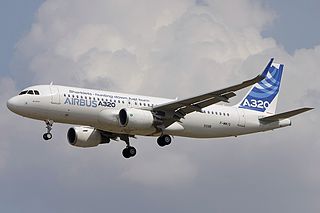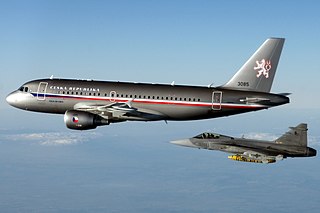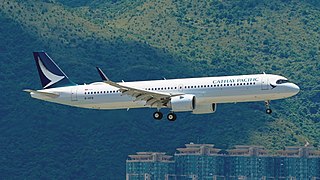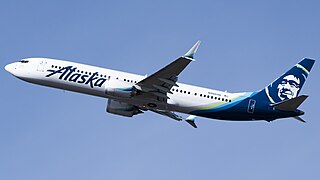
The Airbus A320 family is a series of narrow-body airliners developed and produced by Airbus. The A320 was launched in March 1984, first flew on 22 February 1987, and was introduced in April 1988 by Air France. The first member of the family was followed by the longer A321, the shorter A319, and the even shorter A318 . Final assembly takes place in Toulouse in France; Hamburg in Germany; Tianjin in China since 2009; and Mobile, Alabama in the United States since April 2016.

The Boeing 787 Dreamliner is an American wide-body airliner developed and manufactured by Boeing Commercial Airplanes. After dropping its unconventional Sonic Cruiser project, Boeing announced the conventional 7E7 on January 29, 2003, which focused largely on efficiency. The program was launched on April 26, 2004, with an order for 50 aircraft from All Nippon Airways (ANA), targeting a 2008 introduction. On July 8, 2007, a prototype 787 without major operating systems was rolled out; subsequently the aircraft experienced multiple delays, until its maiden flight on December 15, 2009. Type certification was received in August 2011, and the first 787-8 was delivered in September 2011 before entering commercial service on October 26, 2011, with ANA.

The Airbus A318 is the smallest and least numerous variant airliner of the Airbus A320 family. The A318 carries 107 to 132 passengers and has a maximum range of 5,750 kilometres. Final assembly of the aircraft took place in Hamburg, Germany. It is intended primarily for short-range service.

The CFM International CFM56 series is a Franco-American family of high-bypass turbofan aircraft engines made by CFM International (CFMI), with a thrust range of 18,500 to 34,000 lbf. CFMI is a 50–50 joint-owned company of Safran Aircraft Engines of France, and GE Aerospace (GE) of the United States. GE produces the high-pressure compressor, combustor, and high-pressure turbine, Safran manufactures the fan, gearbox, exhaust and the low-pressure turbine, and some components are made by Avio of Italy and Honeywell from the US. Both companies have their own final assembly line, GE in Evendale, Ohio, and Safran in Villaroche, France. The engine initially had extremely slow sales but has gone on to become the most used turbofan aircraft engine in the world.

General Electric Company, doing business as GE Aerospace, is an American aircraft engine supplier that is headquartered in Evendale, Ohio, outside Cincinnati. It is the legal successor to the original General Electric Company founded in 1892, which split into three separate companies between November 2021 and April 2024, adopting the trade name GE Aerospace after divesting its healthcare and energy divisions.

Safran Aircraft Engines, previously Snecma or Snecma Moteurs, is a French aerospace engine manufacturer headquartered in Courcouronnes and a subsidiary of Safran. It designs, manufactures and maintains engines for commercial and military aircraft as well as rocket engines for launch vehicles and satellites.

The Airbus A350 is a long-range, wide-body twin-engine airliner developed and produced by Airbus. The initial A350 design proposed by Airbus in 2004, in response to the Boeing 787 Dreamliner, would have been a development of the Airbus A330 with composite wings and new engines. Due to inadequate market support, Airbus switched in 2006 to a clean-sheet "XWB" design, powered by two Rolls-Royce Trent XWB high bypass turbofan engines. The prototype first flew on 14 June 2013 from Toulouse, France. Type certification from the European Aviation Safety Agency (EASA) was obtained in September 2014, followed by certification from the Federal Aviation Administration (FAA) two months later.

Safran S.A. is a French multinational aerospace and defense corporation that designs, develops and manufactures aircraft engines, helicopter engines, spacecraft propulsion systems as well as various other aerospace and military equipment. The company arose in 2005 through a merger between SNECMA and defense electronics specialist SAGEM. Safran's acquisition of Zodiac Aerospace in 2018 significantly expanded its aeronautical activities.

The Pratt & Whitney PW1000G, also called the GTF, is a high-bypass geared turbofan engine family produced by Pratt & Whitney. After many demonstrators, the program was launched with the PW1200G on the Mitsubishi SpaceJet in March 2008, first flight tested in July 2008. The first variant to be certified was the PW1500G for the Airbus A220 in February 2013. The program cost is estimated at $10 billion.

Airbus Corporate Jets (ACJ) is a business unit of Airbus which markets and completes business jet variants of the company’s airliners. Following the entry of the 737-based Boeing Business Jet into the market, Airbus introduced the A319-based Airbus Corporate Jet in 1997. Although the term Airbus Corporate Jet was initially used only for the A319CJ, it is now used for all models in a VIP configuration. As of June 2019, 213 corporate and private jets are operating; 222 aircraft have been ordered, including 128 A320 family jets.

The Boeing 737 Next Generation, commonly abbreviated as 737NG, or 737 Next Gen, is a twin-engine narrow-body aircraft produced by Boeing Commercial Airplanes. Launched in 1993 as the third generation derivative of the Boeing 737, it has been produced since 1997.

The CFM International LEAP is a high-bypass turbofan engine produced by CFM International, a 50–50 joint venture between American GE Aerospace and French Safran Aircraft Engines. It is the successor of the CFM56 and competes with the Pratt & Whitney PW1000G to power narrow-body aircraft.

The Comac C919 is a narrow-body airliner developed by Chinese aircraft manufacturer Comac. The development program was launched in 2008. Production began in December 2011, with the first prototype being rolled out on 2 November 2015; the maiden flight took place on 5 May 2017. On 29 September 2022 the C919 received its CAAC type certificate. The first production airframe was delivered to China Eastern Airlines on 9 December 2022 and was put into commercial passenger service on 28 May 2023.

The General Electric Passport is a turbofan developed by GE Aerospace for large business jets. It was selected in 2010 to power the Bombardier Global 7500 and 8000, first run on June 24, 2013, and first flown in 2015. It was certified in April 2016 and powered the Global 7500 first flight on November 4, 2016, before its 2018 introduction. It produces 14,000 to 20,000 lbf of thrust, a range previously covered by the General Electric CF34. A smaller scaled CFM LEAP, it is a twin-spool axial engine with a 5.6:1 bypass ratio and a 45:1 overall pressure ratio and is noted for its large one-piece 52 in (130 cm) fan 18-blade titanium blisk.

The Airbus A321neo is a single-aisle airliner created by Airbus. The A321neo is developed from the Airbus A321 and Airbus A320neo family. It is the longest stretched fuselage of Airbus's A320 series, and the newest version of the A321, with the original A321ceo entering service in 1994 with Lufthansa. It typically seats 180 to 220 passengers in a two-class configuration, with up to 244 passengers in a high-density arrangement.

The Boeing 737 MAX is the fourth generation of the Boeing 737, a narrow-body airliner manufactured by Boeing Commercial Airplanes, a division of American company Boeing. It succeeds the Boeing 737 Next Generation (NG) and competes with the Airbus A320neo family. The new series was announced in August 2011. It took its maiden flight in January 2016 and was certified by the US Federal Aviation Administration (FAA) in March 2017. The first delivery was a MAX 8 in May 2017 to Malindo Air, with which it commenced service in May 2017.

The Airbus A320neo family is an incremental development of the A320 family of narrow-body airliners produced by Airbus. The A320neo family is based on the previous A319, A320, and A321, which was then retroactively renamed the A320ceo family.

The Boeing 777X is the latest series of the long-range, wide-body, twin-engine jetliners in the Boeing 777 family from Boeing Commercial Airplanes. The 777X features new GE9X engines, new composite wings with folding wingtips, greater cabin width and seating capacity, and technologies from the Boeing 787. The 777X was launched in November 2013 with two variants: the 777-8 and the 777-9. The 777-8 provides seating for 384 passengers and has a range of 8,745 nautical miles [nmi] while the 777-9 has seating for 426 passengers and a range of over 7,285 nmi.

N747GE is a Boeing 747 aircraft that was used by General Electric Aircraft Engines as a testbed for several of the companies jet engines between 1992 and 2017, including the GE90 for the Boeing 777, at the time, the world’s largest jet engine.




















